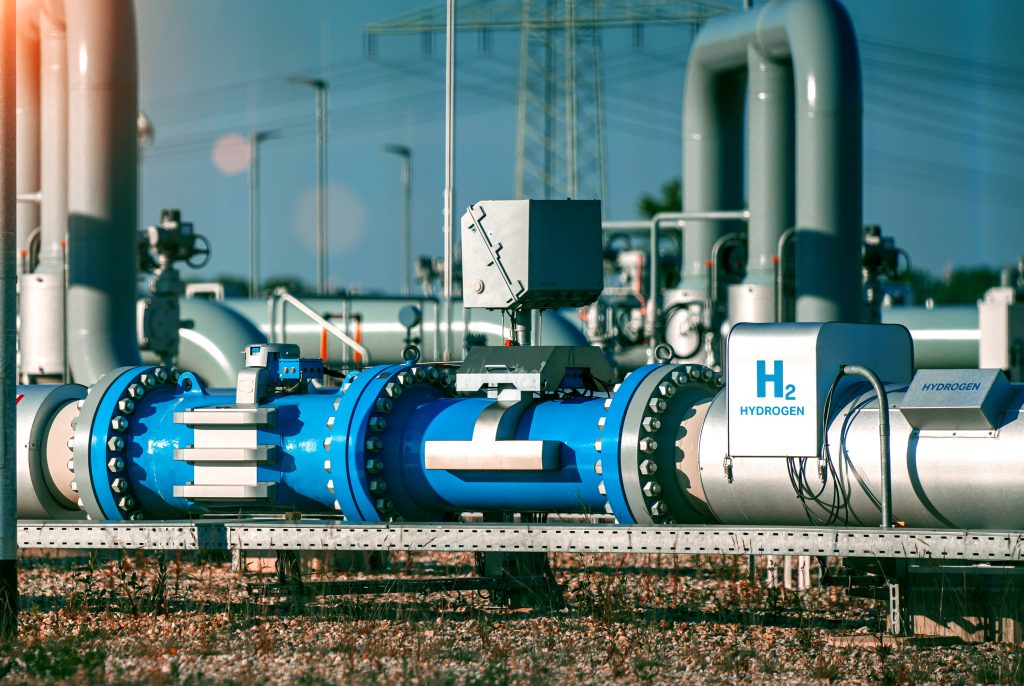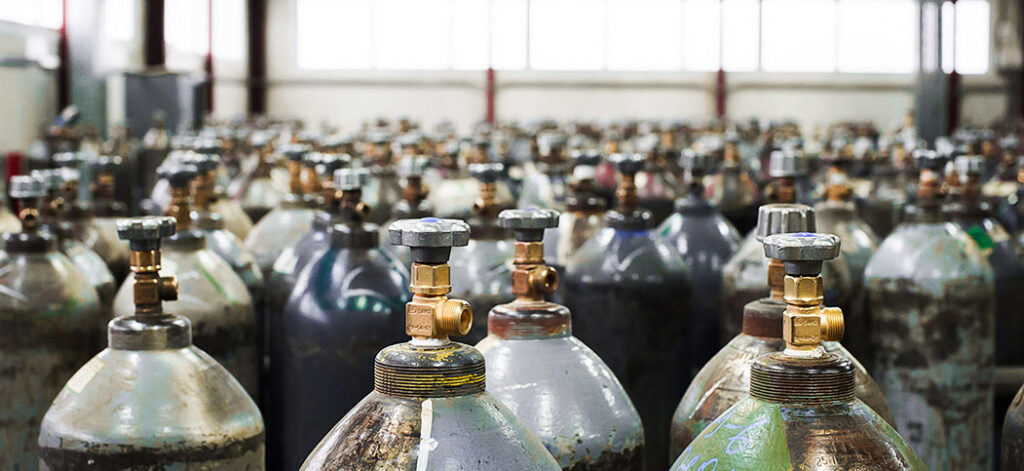| Ammoniak |
0.59 |
NH3 |
Ammoniak is het enige veelvoorkomende alkalische gas. De dichtheid is ongeveer de helft van die van lucht en het heeft een karakteristieke geur. Het maximale veilige niveau is 25 ppm, maar door zijn alkaliteit reageert het zeer sterk met zure gassen en chloor en zijn aanwezigheid in atmosferen met andere gassen wordt hierdoor vaak gemaskeerd. Als ammoniak en chloor bijvoorbeeld in gelijke concentraties aanwezig zijn, is het resultaat een wolk van ammoniumchloride en geen van beide gassen.
Ammoniak is brandbaar met een LEL van 15%. Het wordt wereldwijd in grote hoeveelheden geproduceerd voor kunstmest, ureum voor harsen, explosieven en vezels zoals nylon. Het wordt ook gebruikt als koelgas: deze toepassing neemt toe nu CFK's verdwijnen. Een andere toepassing is het steriel houden van watervoorraden na behandeling met chloor en zwaveldioxide.
|
| Arsine |
2.7 |
ASH3 |
Arsine is een kleurloos, brandbaar en zeer giftig gas. Het heeft een knoflookachtige of visachtige geur die kan worden waargenomen bij concentraties van 0,5 ppm en hoger. Omdat arsine niet irriteert en geen onmiddellijke symptomen veroorzaakt, kunnen personen die blootgesteld worden aan gevaarlijke concentraties zich niet bewust zijn van de aanwezigheid ervan. Het wordt meestal vervoerd in cilinders als een vloeibaar samengeperst gas. Arseengas ontstaat wanneer metalen of ruwe ertsen met arseenonzuiverheden worden behandeld met zuur. Arseengas wordt ook gebruikt in de halfgeleiderindustrie bij het afzetten van arseen op microchips. |
| Broom |
5.5 |
Br2 |
Broom wordt gebruikt om een breed scala aan verbindingen te maken die worden gebruikt in de industrie en landbouw. Broom wordt ook gebruikt bij de productie van ontsmettingsmiddelen, vlamdovende middelen, waterzuiveringsverbindingen, kleurstoffen, geneesmiddelen, ontsmettingsmiddelen, anorganische bromiden voor fotografie, enz. Het wordt ook gebruikt om tussenproducten te vormen in organische synthese, waar het de voorkeur geniet boven jodium vanwege de veel lagere kosten.
Broom wordt gebruikt om gebromeerde plantaardige olie te maken, die wordt gebruikt als emulgator in veel frisdranken met citrussmaak.
Elementair broom is sterk irriterend en veroorzaakt in geconcentreerde vorm pijnlijke blaren op blootgestelde huid en vooral slijmvliezen. Zelfs lage concentraties broomdamp (vanaf 10 ppm) kunnen de ademhaling beïnvloeden en het inademen van grote hoeveelheden broom kan de luchtwegen ernstig beschadigen.
|
| Kooldioxide |
1.53 |
CO2 |
Ondanks het feit dat we uitademen kooldioxide en dat het aanwezig is in de atmosfeer tot ongeveer 400 ppm, het maximale veilige niveau is 5000 ppm (0,5%). Het wordt geproduceerd bij verbranding en in brouw-, distillatie- en andere gistingsprocessen, en is samen met methaan een van de hoofdbestanddelen van stortgas en rioolwaterzuiveringsgistingsgas. CO2 vormt een aanzienlijk gevaar in de brouwerijsector, vooral omdat het gas zwaarder is dan lucht en zich op lage niveaus verzamelt. Er is een zeker risico in drukke, slecht geventileerde ruimten en dit probleem wordt vaak verergerd door zuurstoftekort. CO2 wordt ook gebruikt om de plantengroei te verhogen door het normale niveau in kassen etc. te verhogen.
Het is geur- en kleurloos en moeilijk te meten in ppm-niveaus. Infraroodabsorptie is de gebruikelijke detectietechniek.
|
| Koolmonoxide |
0.97 |
CO |
Koolmonoxidedat geur- en kleurloos is, is het meest voorkomende giftige gas. Het heeft een vergelijkbare dichtheid als lucht, mengt zich gemakkelijk en wordt gemakkelijk ingeademd. Het is een bekende "sluipmoordenaar" in huiselijke omgevingen.
Elk proces waarbij koolstofbrandstof onvolledig wordt verbrand, produceert waarschijnlijk koolmonoxide. Bijvoorbeeld: benzine- en dieselmotoren, kolen-, gas- en olieketels en zelfs roken. De aanwezigheid van koolmonoxide in mijnen is te wijten aan de langzame verbranding van steenkool.
Het wordt ook in enorme hoeveelheden gebruikt als goedkoop chemisch reductiemiddel, bijvoorbeeld bij de staalproductie en andere metaalraffinage- en warmtebehandelingsprocessen, en bij de productie van methanol door reactie met waterstof.
|
| Chloor |
2.5 |
Cl2 |
Chloor is een scherp ruikend, bijtend, groen/geel gas. Het bekendste gebruik is in waterzuivering voor huishoudelijk gebruik en in zwembaden. Het wordt gebruikt om gechloreerde verbindingen te maken, zoals PVC, en voor het bleken van papier en stoffen. Het is een zeer zwaar gas en wordt gemakkelijk geabsorbeerd door de meeste materialen.
Het gedrag van chloor maakt het een zeer moeilijk gas om te detecteren (zo moeilijk dat zelfs kalibratie speciale technieken vereist).
Het gebruik van de Crowcon Environmental Sampling Unit is een effectieve manier om chloor met succes op te sporen in chlooropslagplaatsen en dit minimaliseert het aantal detectoren dat nodig is.
|
| Chloordioxide |
2.3 |
ClO2 |
Chloordioxide is een roodachtig geel gas dat een van de bekende chlooroxiden is. Het kan spontaan en explosief ontleden in chloor en zuurstof. Chloordioxide wordt voornamelijk gebruikt voor het bleken van houtpulp, maar ook voor het bleken van meel en het desinfecteren van water.
Chloordioxide wordt ook gebruikt in combinatie met ozon voor desinfectie van water om de vorming van bromaten te verminderen, die gereguleerde kankerverwekkende stoffen zijn.
Chloordioxide wordt in veel industriële waterbehandelingstoepassingen gebruikt als biocide, waaronder koeltorens, proceswater en voedselverwerking. Bij inademing veroorzaakt chloordioxidegas irritatie in neus, keel en longen.
|
| Diborane |
0.96 |
B2H6 |
Diborane heeft een geurdrempel tussen 2 en 4 ppm, wat aanzienlijk hoger is dan de blootstellingslimiet van 0,1 ppm. Langdurige blootstelling aan lage concentraties, zoals op de werkplek, kan leiden tot reukmoeheid en tolerantie voor de irriterende effecten van diboraan.
Zoals bij alle giftige gassen is de geur niet voldoende om te waarschuwen voor gevaarlijke concentraties.
Diboraan is lichter dan lucht en blootstelling kan leiden tot irritatie van de huid, luchtwegen en ogen in slecht geventileerde, afgesloten of laaggelegen gebieden. Diboraan wordt gebruikt in raketdrijfgassen, als vulcanisator voor rubber, als katalysator voor polymerisatie van koolwaterstoffen, als vlamversneller en als doteringsmiddel voor de productie van halfgeleiders.
|
| Ethyleenoxide (ETO) |
1.52 |
C2H4O |
Ethyleenoxide wordt gebruikt als tussenproduct bij de productie van ethyleenglycol, dat op grote schaal wordt gebruikt als koelvloeistof voor auto's en als antivriesmiddel. Het wordt ook gebruikt om voedingsmiddelen en medische benodigdheden te steriliseren. Het is een kleurloos brandbaar gas of koelvloeistof met een lichtzoete geur. Ethyleenoxide doodt bacteriën, schimmels en zwammen en kan worden gebruikt om stoffen te steriliseren die zouden worden beschadigd door sterilisatietechnieken zoals pasteurisatie die gebaseerd zijn op warmte. Daarnaast wordt ethyleenoxide veel gebruikt voor het steriliseren van medische benodigdheden zoals verbanden, hechtingen en chirurgische instrumenten.
Ethyleenoxide is giftig bij inademing. Symptomen van overmatige blootstelling zijn hoofdpijn en duizeligheid, die met toenemende blootstelling evolueren naar convulsies, toevallen en coma. Bij inademing kunnen de longen zich enkele uren na blootstelling vullen met water.
|
| Fluor |
1.3 |
F2 |
Atoom fluor en moleculair fluor worden gebruikt voor plasma-etsen bij de productie van halfgeleiders en platte beeldschermen. Fluor wordt toegevoegd aan sommige stadswatervoorzieningen in een verhouding van ongeveer één deel per miljoen om tandbederf te helpen voorkomen.
Fluorverbindingen, waaronder natriumfluoride, worden gebruikt in tandpasta om gaatjes in de tanden te voorkomen. Fluor is zeer giftig en moet met grote voorzichtigheid worden behandeld. Contact met de huid en ogen moet strikt worden vermeden.
Fluor is een krachtige oxidator die organisch materiaal, brandbare stoffen of andere brandbare materialen kan doen ontbranden.
|
| Germane |
2.65 |
GeH4 |
Germane verbrandt in lucht om GeO2 en water.
Germaan wordt gebruikt in de halfgeleiderindustrie voor de epitaxiale groei van germanium door MOVPE of chemische bundelepitaxie. Germaan is brandbaar, giftig en verstikkend.
|
| Waterstofcyanide |
0.94 |
HCN |
Waterstofcyanide is een bekend gif dat een kleurloos, zoet ruikend gas is met een maximaal veilig niveau van 10 ppm in 15 minuten. De belangrijkste industriële toepassing is goudraffinage. |
| Waterstofchloride |
1.3 |
HCL |
Waterstofchloride is een zeer corrosief en giftig kleurloos gas dat witte dampen vormt bij contact met vocht. Deze dampen bestaan uit zoutzuur dat wordt gevormd wanneer waterstofchloride oplost in water. Waterstofchloridegas en zoutzuur zijn belangrijk in de industrie, vooral in de farmaceutische industrie, halfgeleiders en de behandeling van rubber en katoen. Het wordt ook uitgestoten door afvalverbrandingsovens waarin PVC wordt verbrand. Inademing van de dampen kan hoesten, verstikking, ontsteking van neus, keel en bovenste luchtwegen en in ernstige gevallen de dood tot gevolg hebben. |
| Waterstoffluoride |
0.92 |
HF |
Waterstoffluoride wordt gebruikt voor aardolieraffinage, glasfabricage, aluminiumproductie, titaanbeitsing, kwartszuivering en metaalafwerking.
Waterstoffluoride veroorzaakt irritatie van ogen, neus en huid. Het inademen van een grote hoeveelheid HF kan ook schadelijk zijn voor de longen, het hart en de nieren en kan uiteindelijk de dood tot gevolg hebben. Het kan ook de ogen en huid verbranden.
|
| Waterstofsulfide |
1.2 |
H2S |
Waterstofsulfide is bekend om zijn slechte eiergeur, die geroken kan worden tot minder dan 0,1 ppm. Hoge concentraties (>60ppm) kunnen niet geroken worden door verlamming van de reukklieren en blootstelling kan leiden tot onmiddellijke verlamming. H2S is iets zwaarder dan lucht en daarom worden vaste detectoren meestal 1 tot 1,5 meter van de grond of in de buurt van potentiële lekkagebronnen gemonteerd.
H2Swordt geproduceerd tijdens het rotten van organische materialen, wordt geëxtraheerd met olie (wanneer de olie zogenaamd zuur is) en wordt vaak ondergronds aangetroffen tijdens het graven van tunnels en in riolen. Het is een bestanddeel van biogas en wordt in grote hoeveelheden aangetroffen in rioolwaterzuiveringsinstallaties, pompstations, pershuizen, ketelhuizen en vrijwel overal waar rioolwater wordt behandeld. Het heeft een aantal industriële toepassingen en wordt geproduceerd als bijproduct bij andere toepassingen (bijv. vezelproductie).
|
| Methyl Mercaptan |
1.66 |
CH3SH |
Mercaptan wordt toegevoegd aan aardgas (methaan) om het gemakkelijker op te sporen in geval van een lek: aardgas in zijn oorspronkelijke staat is kleurloos en reukloos. Kwiktaan bevat zwavel en heeft een sterke geur die lijkt op rotte kool of slechte eieren. Door mercaptaan aan aardgas toe te voegen, kunnen lekken van boilers, ovens en warmwatertoestellen gemakkelijk worden opgespoord zonder dat er dure apparatuur nodig is.
Andere toepassingen van mercaptaan in de industrie zijn onder andere vliegtuigbrandstof, farmaceutica, veevoederadditieven, chemische fabrieken, de kunststofindustrie en pesticiden. Het is een natuurlijke stof die voorkomt in het bloed, de hersenen en andere weefsels van mensen en dieren. Het komt vrij uit de uitwerpselen van dieren. Het komt van nature voor in bepaalde voedingsmiddelen, zoals sommige noten en kaas. Mercaptaan is minder corrosief en minder giftig dan vergelijkbare zwavelverbindingen (H2S).
Aanbevolen maximale blootstellingsniveaus in Noord-Amerika variëren van 0,5 ppm (NIOSH 15-minutengrens) tot 10 ppm (OSHA Permissible Exposure Limit).
De Britse Heath and Safety Executive heeft geen waarde vastgesteld voor een blootstellingslimiet op de werkplek.
|
| Lachgas
Stikstofoxide
Stikstofdioxide
|
1.53
1.04
1.60
|
N2O,
GEEN
NO2
|
Er zijn drie stikstofoxiden. Lachgas (of Lachgas) heeft een LTEL (volgens document EH40) van 100ppm. Het heeft geen STEL-waarde. De dood kan het gevolg zijn als het op zo'n manier wordt ingeademd dat er niet genoeg zuurstof wordt ingeademd. Het inademen van lachgas van industriële kwaliteit is ook gevaarlijk, omdat het veel onzuiverheden bevat en niet bedoeld is voor gebruik bij mensen. Lachgas is een zwak algemeen verdovingsmiddel en wordt over het algemeen niet alleen gebruikt bij anesthesie. Omdat het echter een zeer lage toxiciteit op korte termijn heeft en een uitstekend pijnstillend middel is, wordt een 50/50 mengsel van lachgas en zuurstof vaak gebruikt tijdens bevallingen, voor tandheelkundige ingrepen en in de spoedeisende geneeskunde.
Stikstofmonoxide (moderne naam stikstofmonoxide) en stikstofdioxide zijn de bestanddelen van zogenaamde NOx die samen met zwaveldioxide zure regen veroorzaken. De belangrijkste oorzaak van deze gassen in de atmosfeer is de verbranding van fossiele brandstoffen in voertuigmotoren en elektriciteitscentrales. Op het punt waar de uitlaatgassen vrijkomen, vormt stikstofmonoxide ongeveer 90% van de NOx. Het reageert echter spontaan met zuurstof in de open atmosfeer om stikstofdioxide te produceren. Stikstofoxide is een kleurloos gas, maar stikstofdioxide is een zuur, scherp ruikend, bruin gas.
|
| Ozon |
1.6 |
O3 |
Ozon is een onstabiel gas en wordt gegenereerd wanneer het nodig is. Het wordt steeds vaker gebruikt in plaats van chloor voor de behandeling van water. Het kan elektrochemisch worden gedetecteerd bij lage ppm-niveaus. |
| Fosgeen |
3.48 |
COCL2 |
Fosgeen is een belangrijke industriële chemische stof die wordt gebruikt bij de productie van kunststoffen, kleurstoffen en pesticiden. Het wordt ook gebruikt in de farmaceutische industrie. Fosgeen gas kan kleurloos zijn of als een witte tot lichtgele wolk verschijnen. Bij lage concentraties heeft het een aangename geur van pas gemaaid hooi of groene maïs, maar de geur wordt niet door alle blootgestelde mensen opgemerkt. Bij hoge concentraties kan de geur sterk en onaangenaam zijn.
Zoals bij alle giftige gassen is de geur niet voldoende om te waarschuwen voor gevaarlijke concentraties.
Fosgeen is zwaarder dan lucht, dus het wordt eerder aangetroffen in laaggelegen gebieden.
Fosgeen gas kan de huid, ogen, neus, keel en longen beschadigen.
|
| Fosfine |
1.2 |
PH3 |
Fosfine is zeer giftig en heeft daarom eenSTEL van slechts 0,3ppm. Fosfaatgas wordt gebruikt voor ongediertebestrijding door fumigatie. Fosfine wordt ook gebruikt in de halfgeleiderindustrie. |
| Silaan |
1.3 |
SiH4 |
Silaan is bij kamertemperatuur een gas en is pyrofoor, wat betekent dat het spontaan ontbrandt in lucht, zonder dat er een externe ontsteking nodig is.
Silaan kent verschillende industriële en medische toepassingen. Silanen worden bijvoorbeeld gebruikt als koppelmiddel om glasvezels aan een polymeermatrix te hechten, waardoor het composietmateriaal wordt gestabiliseerd. Toepassingen zijn onder andere waterafstotende middelen, afdichting en bescherming van metselwerk en beton, bestrijding van graffiti en het aanbrengen van polykristallijne siliciumlagen op siliciumwafers bij de productie van halfgeleiders en afdichtmiddelen. Gezondheidseffecten zijn onder andere hoofdpijn, misselijkheid en ernstige irritatie van de huid, ogen en luchtwegen.
|
| Zwaveldioxide |
2.25 |
SO2 |
Zwaveldioxide is kleurloos en heeft een karakteristieke verstikkende geur. Het wordt gevormd bij de verbranding van zwavel en zwavelhoudende materialen zoals olie en steenkool. Het is zeer zuur en vormt zwavelzuur wanneer het in water wordt opgelost. Samen met stikstofoxiden is het een oorzaak van zure regen.
SO2wordt aangetroffen in industriële gebieden en in de buurt van elektriciteitscentrales en is een grondstof voor veel processen. Het wordt gebruikt bij de behandeling van water om overtollig chloor te verdringen en vanwege de steriliserende eigenschappen wordt het gebruikt in de voedselverwerking. Het is twee keer zo zwaar als lucht en heeft de neiging om naar de grond te vallen, dus een Crowcon milieubemonsteringseenheid in de buurt van de grond zorgt voor een snelle opsporing in geval van een lek.
Opmerking: Zwaveltrioxide S03 komt voor in de uitlaatgassen van elektriciteitscentrales. Het is geen gas maar een vaste stof die gemakkelijk sublimeert (d.w.z. dat het bij verhitting overgaat van vaste naar gasvormige toestand).
|
| Zwavelhexafluoride |
5 |
SF6 |
SF6 wordt gebruikt in de elektriciteitsindustrie als gasvormig isolatiemedium, zeer goed bestand tegen elektrische stroom, voor hoogspanningsstroomonderbrekers, schakelapparatuur en andere elektrische apparatuur. SF6 gas onder druk wordt gebruikt als isolator in gasgeïsoleerd schakelmateriaal (GIS) omdat het een veel hogere diëlektrische sterkte heeft dan lucht of droge stikstof. Hoewel de meeste ontledingsproducten de neiging hebben om SF6Bij vonk- of coronaboogvorming kan zwavelafluoride (S2F10), een zeer giftig gas, met een toxiciteit vergelijkbaar met die van fosgeen.
SF6-plasma wordt ook gebruikt in de halfgeleiderindustrie als etsmiddel en in de magnesiumindustrie. Het is met succes gebruikt als een tracer in oceanografie om diapycnale vermenging en lucht-zee gasuitwisseling te bestuderen. Het wordt ook uitgestoten tijdens het smeltproces van aluminium.
Wanneer SF6 wordt ingeademd, neemt de toonhoogte van iemands stem dramatisch af omdat de geluidssnelheid in SF6 aanzienlijk lager is dan in lucht. Dit effect is vergelijkbaar met dat van lachgas. Omdat SF6 vijf keer zwaarderis dan lucht, verdringt het de zuurstof die nodig is om te ademen. Sporen van giftige zwaveltetrafluoride kunnen ernstige gevolgen hebben voor de gezondheid.
De UK Heath and Safety Executive heeft een waarde vastgesteld voor de 8-uurs grenswaarde voor blootstelling op de werkplek (WEL) van 1000 ppm.
|
| Vluchtige organische stoffen |
n.v.t. |
VOC's |
Vluchtige organische stoffen (VOC's) worden uitgestoten als gassen uit bepaalde vaste stoffen of vloeistoffen. VOC's omvatten een verscheidenheid aan chemische stoffen, waarvan sommige op korte en lange termijn schadelijke effecten kunnen hebben op de gezondheid. VOC's kunnen worden aangetroffen in huishoudelijke of commerciële omgevingen binnenshuis door emissies van huishoudelijke schoonmaakproducten, pesticiden, bouwmaterialen, kantoorapparatuur zoals kopieerapparaten en printers, grafische en ambachtelijke materialen zoals lijm en kleefmiddelen, permanente markers en fotografische oplossingen.
Brandstoffen bestaan uit organische chemicaliën en kunnen organische verbindingen afgeven tijdens het gebruik en, tot op zekere hoogte, wanneer ze worden opgeslagen.
Gevolgen voor de gezondheid zijn onder andere irritatie van ogen, neus en keel, hoofdpijn, coördinatieverlies, misselijkheid, schade aan lever, nieren en centraal zenuwstelsel. De belangrijkste tekenen of symptomen van blootstelling aan VOC's zijn neus- en keelklachten, hoofdpijn en huidreacties.
Net als bij andere verontreinigende stoffen zijn de omvang en de aard van het gezondheidseffect afhankelijk van veel factoren, waaronder het blootstellingsniveau en de blootstellingsduur.
Veel voorkomende VOC's zijn acetaldehyde, butadieen, koolstofdisulfide, dimethylsulfide, ethanol, ethyleen, methanol, methylmercaptaan, tolueen, vinylacetaat, aceton, benzeen, ethylacetaat, methylamine, methylethylketon, tetrachloorethyleen en vinylchloride. VOC's kunnen worden gedetecteerd met PID-sensoren of in sommige gevallen elektrochemische sensoren.
|
| Freonen |
|
|
In het algemeen, Freonen zijn koolstofverbindingen die chloor, fluor en/of broom bevatten. Freonen worden veel gebruikt in de industrie vanwege hun hoge dichtheid, lage kookpunten, lage viscositeit en lage oppervlaktespanning. Bovendien zijn ze gemakkelijk vloeibaar te maken, waardoor ze ideaal zijn als koelmiddel en oplosmiddel. Freonen worden veel gebruikt als oplosmiddel, drijfgas, brandblusser en blaasmiddel.
Freongassen worden geclassificeerd met behulp van 'R'-nummers. R125 is bijvoorbeeld pentafluorethaan (CHF2-CF3).
Freonverbindingen zijn onder andere chloorfluorkoolstoffen of CFK's. De eigenschap van inertheid die CFK's zo nuttig maakt in de industrie, blijkt de factor te zijn die ze zo gevaarlijk maakt voor onze planeet. CFK's worden van nature niet afgebroken en als gevolg daarvan blijven ze na uitstoot in de atmosfeer hangen en dragen ze bij aan de afbraak van de ozonlaag. Freonen kunnen worden gedetecteerd met halfgeleiders of IR-sensoren.
|

















